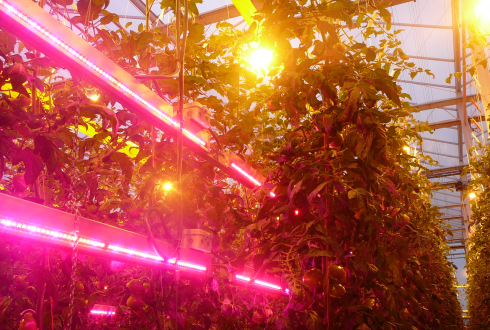Wageningen, The Netherlands
August 28, 2013

The tomato trial ended at the end of August. Almost 90 kg of tomatoes per m2 were produced in one year! In a trial like this, the first question growers always is how much production was achieved. But we also learned more from growing these crops.
Four different light treatments in four greenhouses were used for the tomato cultivar Komeett. In addition to a reference crop with only HPS lighting, equal light intensities were realized by two hybrid systems combining HPS top light and LED interlighting, and a hybrid LED top light and LED interlighting. One of the crops under hybrid HPS and LED interlighting were performed in a greenhouse with diffuse glass. This crop was expected to benefit from more light penetration deeper into the crop, from both artificial interlighting as well as from diffuse light. And that is what happened: 89.1 kg per m2 is 6.6% more than in the reference crop. Under the same hybrid lighting, but without diffuse glass 1.6% more tomatoes were produced than in the reference crop. The combination LED top light and LED interlighting also produced a healthy and well-producing crop. Here, the absence of heat radiation from the HPS lamps which lowers the plant temperature, was compensated for by maintaining a slightly higher greenhouse air temperature. A model calculated the light requirement of the crop, and was then used to provide the right amount of light. Thus, only the required amount of light was given and that was favourable for use of electricity.
Diffuse light in the winter is positive
The fact that diffuse light increases the light sum and tomato production in the winter has been demonstrated once more. More light was measured under diffuse glass than under standard glass, probably because condensation increased the light transmission of the glass. This was the case especially during the winter, with 5% more production during the winter as a result. Production is optimized by finding the proper balance between vegetative and generative growth. Temperature plays an important role as well. In this experiment, we learned that the crop can be better controlled, by maintaining an extra stem earlier in the season, in addition to some leaf picking in the top of crop. Both under LED interlighting and diffuse glass, it is advantageous not to pick leaves lower on the stem. After all, these leaves remain green for a longer time. The leaf quality under HPS lamps was clearly the lowest.
Tomatenproef verschillend belicht - Het Nieuwe Belichten onder diffuus glas succesvol
De tomatenproef binnen het project Het Nieuwe Belichten liep eind augustus af. In een teelt van exact een jaar is er bijna 90 kilo tomaten per m2 geproduceerd! In een proef als deze, vragen telers allereerst naar de behaalde productie. Maar we hebben ook veel opgestoken van deze teelten.
In vier kassen zijn vier lichtbehandelingen toegepast op het tomatenras Komeett. Naast een referentieteelt met alleen SON-T belichting, is er evenveel belichting gegeven door twee hybride-belichtingssystemen met de combinatie SON-T bovenlicht en LED tussenlicht en één met LED bovenlicht en LED tussenlicht. Eén van de teelten onder SON-T en LED belichting vond plaats in een kas met diffuus glas. Deze teelt zou moeten profiteren van meer licht dieper in het gewas, zowel van kunstmatig tussenlicht als van diffuus licht. Dat is ook gebeurd: met 89.1 kg per m2 is er 6,6% meer geoogst dan bij de referentie. Onder dezelfde hybride belichting, maar dan zonder diffuus glas bedroeg de meerproductie 1,6%. De combinatie LED boven- en LED tussenbelichting leverde ook een gezond en goed producerend gewas op. Hierbij is de lagere koptemperatuur als gevolg van de afwezigheid van de warmtestraling uit SON-T lampen goed opgevangen door bij lagere koptemperaturen een iets hogere kasluchttemperatuur aan te houden. Met een model is steeds de lichtbehoefte van het gewas berekend. Er is dus tijdens de proef niet meer licht gegeven dan nodig was en dat was gunstig voor het elektriciteitsverbruik.
Diffuus licht ook in de winter positief
Er is weer aangetoond dat diffuus glas de lichtsom en productie in de winter verhoogt. Er is meer licht gemeten onder diffuus glas dan onder standaard glas, waarschijnlijk grotendeels doordat condens de lichttransmissie van het glas verhoogt. Vooral tijdens de winter was dit het geval, met een meerproductie van rond de 5% in de winter als gevolg. De productie wordt ge-optimaliseerd door een goede balans te vinden tussen een generatieve en vegetatieve groei. De temperatuur speelt hierin een belangrijke rol.
In dit experiment werd geleerd dat meer sturing van het gewas mogelijk is door eerder een extra stengel aan te houden, maar dan wel bovenin extra blaadjes te verwijderen. Zowel bij LED tussenbelichting als bij diffuus glas is het gunstig om onderin het blad juist minder snel te verwijderen. Dit blad blijft immers langer groen. De bladkwaliteit was in de proef bij alleen SON-T belichting duidelijk het zwakst.